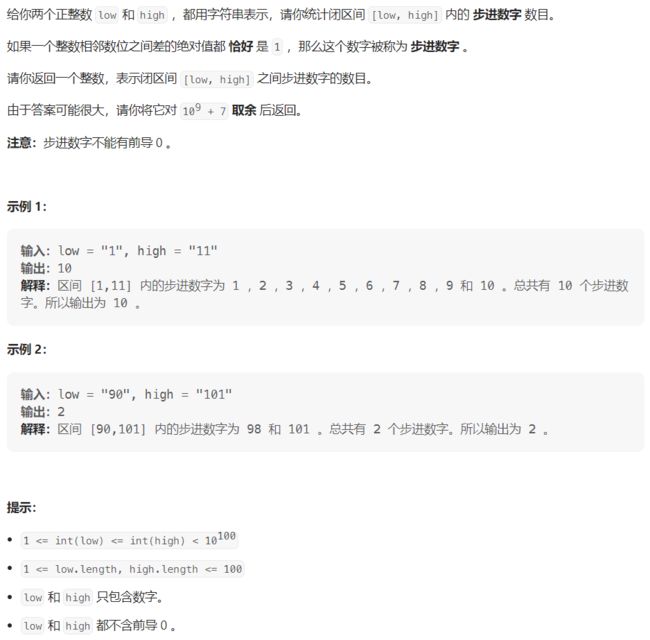第 356 场力扣周赛题解
A 满足目标工作时长的员工数目
签到题
class Solution {
public:
int numberOfEmployeesWhoMetTarget(vector<int> &hours, int target) {
int res = 0;
for (auto x: hours)
if (x >= target)
res++;
return res;
}
};
B 统计完全子数组的数目
枚举子数组:枚举子数组的长度,滑动窗口枚举定长子数组,同时维护数组中不同元素的数目
class Solution {
public:
int countCompleteSubarrays(vector<int> &nums) {
int n = nums.size();
int mx = *max_element(nums.begin(), nums.end());
vector<int> cnt(mx + 1);
for (auto x: nums)
cnt[x] = 1;
int tar = accumulate(cnt.begin(), cnt.end(), 0);//数组中不同元素的数目
int res = 0;
for (int len = 1; len <= n; len++) {
fill(cnt.begin(), cnt.end(), 0);
int cur = 0;
for (int i = 0; i < len - 1; i++)
if (cnt[nums[i]]++ == 0)
cur++;
for (int i = 0, j = i + len - 1; j < n; i++, j++) {
if (cnt[nums[j]]++ == 0)
cur++;
if (cur == tar)
res++;
if (--cnt[nums[i]] == 0)
cur--;
}
}
return res;
}
};
C 包含三个字符串的最短字符串
枚举排列: 若 a , b , c a, b, c a,b,c存在一个串是另一个串的子串的情况,则先删除 a , b , c a, b, c a,b,c中的子串,再枚举剩余串的出现顺序,对于给定顺序每两个邻接串共用尽可能长的公共部分(eg:
abc和bcd拼接共用bc)
class Solution {
public:
string get(string &a, string &b) {//返回拼接a和b的最短串
for (int k = min(b.size(), a.size()); k > 0; k--) {
int i, j;
for (i = a.size() - k, j = 0; j < k; i++, j++)
if (a[i] != b[j])
break;
if (j == k)
return a + b.substr(k);
}
return a + b;
}
string minimumString(string a, string b, string c) {
vector<string> li{a, b, c};
sort(li.begin(), li.end(), [](string &s1, string &s2) { return s1.size() < s2.size(); });
int cnt = 3;//剩余串的个数
if (li[1].find(li[0]) != li[1].npos || li[2].find(li[0]) != li[2].npos) {//li[0]是某串的子串所以删除
li.erase(li.begin());
if (li[1].find(li[0]) != li[1].npos)//只剩1个串的情况
return li[1];
cnt = 2;
}
if (li[2].find(li[1]) != li[2].npos) {li[1]是某串的子串所以删除
li.erase(li.begin() + 1);
cnt = 2;
}
if (cnt == 2) {
string s1 = get(li[0], li[1]);
string s2 = get(li[1], li[0]);
if (s1.size() != s2.size())
return s1.size() < s2.size() ? s1 : s2;
return s1 < s2 ? s1 : s2;
}
sort(li.begin(), li.end());
string res(305, ' ');
do {//枚举a,b,c串的排列顺序
string t = get(li[0], li[1]);
t = get(t, li[2]);
if (t.size() < res.size() || t.size() == res.size() && t < res)
res = t;
} while (next_permutation(li.begin(), li.end()));
return res;
}
};
D 统计范围内的步进数字数目
定义 s u m ( s ) sum(s) sum(s)为闭区间 [ 1 , s ] [1,s] [1,s]内的的步进数字数目,则区间 [ l o w , h i g h ] [low,high] [low,high]内的的步进数字数目为 s u m [ h i g h ] − s u m [ l o w ] sum[high]-sum[low] sum[high]−sum[low](若 l o w low low为步进数字则还要 + 1 +1 +1),定义 p l o c , p r e , v a l , e q l p_{loc,pre,val,eql} ploc,pre,val,eql为在 “当前待处理的下标为 l o c loc loc,前一位选择的数字(若存在)为 p r e pre pre, v a l val val:前面是否有选择数字(0:没有,1:有), e q l eql eql:前面选择的数是否严格等于 s [ 0 , l o c − 1 ] s[0,loc-1] s[0,loc−1](0:否,1:是)” 这种情况下可以构成多少个 [ 1 , s ] [1,s] [1,s]内的步进数字,通过记忆化搜索进行计算。
class Solution {
public:
typedef long long ll;
ll mod = 1e9 + 7;
int countSteppingNumbers(string low, string high) {
int islow = 1;
for (int i = 1; i < low.size(); i++)//判断low是否是步进数字
if (abs(low[i] - low[i - 1]) != 1)
islow = 0;
return ((sum(high) - sum(low) + islow) % mod + mod) % mod;
}
ll sum(string &s) {
int n = s.size();
ll p[n + 1][10][2][2];
memset(p, -1, sizeof(p));
function<ll(int, int, int, int)> get = [&](int loc, int pre, int val, int eql) {
if (p[loc][pre][val][eql] != -1)
return p[loc][pre][val][eql];
if (loc == n) {//已处理完每一位
return p[loc][pre][val][eql] = val;
}
ll &cur = p[loc][pre][val][eql];
cur = 0;
if (val) {//前面有数字
if (!eql) {//前面选择的数不严格等于s[0,loc-1]
if (pre != 0) {
cur += get(loc + 1, pre - 1, val, eql);
cur %= mod;
}
if (pre != 9) {
cur += get(loc + 1, pre + 1, val, eql);
cur %= mod;
}
} else {//前面选择的数严格等于s[0,loc-1]
if (pre != 0 && pre - 1 <= s[loc] - '0') {
cur += get(loc + 1, pre - 1, val, pre - 1 == s[loc] - '0' ? 1 : 0);
cur %= mod;
}
if (pre != 9 && pre + 1 <= s[loc] - '0') {
cur += get(loc + 1, pre + 1, val, pre + 1 == s[loc] - '0' ? 1 : 0);
cur %= mod;
}
}
} else {//前面没有数字
cur += get(loc + 1, 0, val, 0);
if (!eql) {//前面选择的数不严格等于s[0,loc-1]
for (int i = 1; i <= 9; i++) {
cur += get(loc + 1, i, 1, 0);
cur %= mod;
}
} else {//前面选择的数严格等于s[0,loc-1]
for (int i = 1; i <= s[loc] - '0'; i++) {
cur += get(loc + 1, i, 1, i == s[loc] - '0' ? 1 : 0);
cur %= mod;
}
}
}
cur = (cur + mod) % mod;
return cur;
};
return get(0, 0, 0, 1);
}
};



